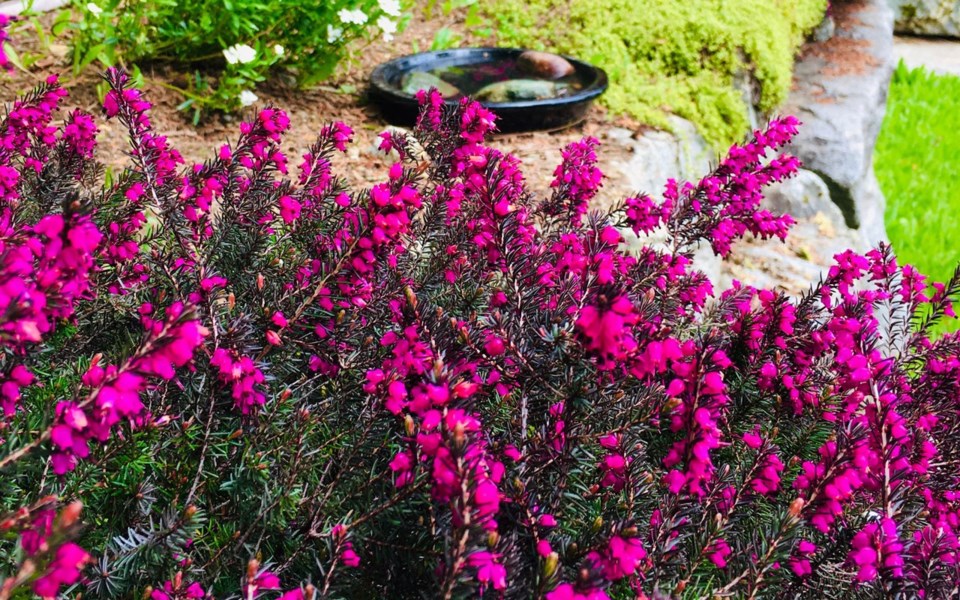If we have been able, most of us have been spending a lot more time outside as we spread out in Phase 2 of B.C.'s re-opening plan for COVID-19.
And, for the last several weeks, people have been re-discovering the joys and trials of gardening as well with self-isolation keeping us close to home. Whether it's in your backyard, on your deck, or in a community plot, it feels like tilling our bit of soil helps keep the monsters at bay.
I am fortunate enough to have a yard, which is pretty low maintenance in general as there just doesn't seem to be enough hours in the day to truly work some magic in it. But it has two plants I have tended and talked to and loved over the years—large, bushy, purple heather shrubs.
In these past two months of having to work from home, I find myself going out to the backyard to root out a few weeds almost every day, and to visit the heather. On one of those days—a sunny one not too long ago—I found myself just standing there staring at the heather and listening. At first I thought I was finally losing it in lockdown. But as I adjusted I realized that yes, indeed, the heather was alive and it was humming—those two plants were covered in a whole variety of bees.
I'm sure those bees have been coming to the heather for years, but I have never taken the time to really notice.
Coincidentally, this past week we celebrated the United Nation's (UN) World Bee Day, which fell on May 20—all this got me buzzing about how our pollinators are doing and what I could do to help, beyond the heather.
World Bee Day was proclaimed by the UN starting in 2018 to raise awareness and action in support of bees and their role as pollinators. More than two-thirds of food crops we eat need native bees, honeybees and other pollinators to successfully produce a crop. All around the world, intensified agriculture with its related loss of habitat, and massive increase in pesticide and herbicide use, has taken a toll on the bee population—including in Canada.
And just this past February, researchers published findings in the journal
Science which showed a decline in some bumblebee species by 46 per cent across North America and 17 per cent in Europe relative to a baseline period of 1901 to 1974 due to climate change and other factors.
We have been reading about bee and pollinator declines for several years now, with campaigns launched by high-profile organizations like the UN, Friends of the Earth, the David Suzuki Foundation and others to raise awareness and demand action by governments, farmers, everyone.
Beyond creating change at the government level, the focus of the groups is very much on getting all of us to create spaces that attract pollinators, including bees.
"Your home and its yard have been your refuge during COVID-19. We're asking you to share that refuge with native bees," said Beatrice Olivastri, CEO of Friends of the Earth, Canada this week. "COVID-19 has made us even more aware of food security and the importance of locally grown produce. Honeybees are the world's tiniest livestock, living in hives managed by beekeepers ... But Canada's 850-plus wild, native bees are mainly solitary, ground nesting and on their own for survival. They need your help. Please offer them refuge in your yard."
And this is something we can all do now—even on your deck—even though we are locked down. In fact, doing it might even give you a bit if a lift, as it did our family.
Fortunately, our garden already has the awesome heather. To that we added a bee pond—a flat dish with a few rocks in it that pollinators can land on and drink from and wash and we have a bee hotel too (though we have to do some renovating to make it work—see davidsuzuki.org/queen-of-green/choose-best-mason-bee-home-make-one).
We are letting our dandelions bloom on the outskirts of our green spaces and I'm planting some more bee-friendly plants such as yarrow, cornflower, perennial asters and calendula.
While this sounds light-hearted and pleasant, the necessity for it covers a dark and scary reality.
Pollination is a fundamental process for the survival of our ecosystems. Nearly 90 per cent of the world's wild flowering plant species depend, entirely, or at least in part, on animal pollination, along with more than 75 per cent of the world's food crops and 35 per cent of global agricultural land. Not only do pollinators contribute directly to food security, but they are key to conserving biodiversity.
Present species extinction rates are 100 to 1,000 times higher than normal due to human impacts. Close to 35 per cent of invertebrate pollinators, particularly bees and butterflies, and about 17 percent of vertebrate pollinators, such as bats, face extinction globally.
So, while spending some time planting bee-friendly plants may seem an innocuous pastime, you are, in fact, helping to save pollinators and in the long term, you are helping to save mankind.




